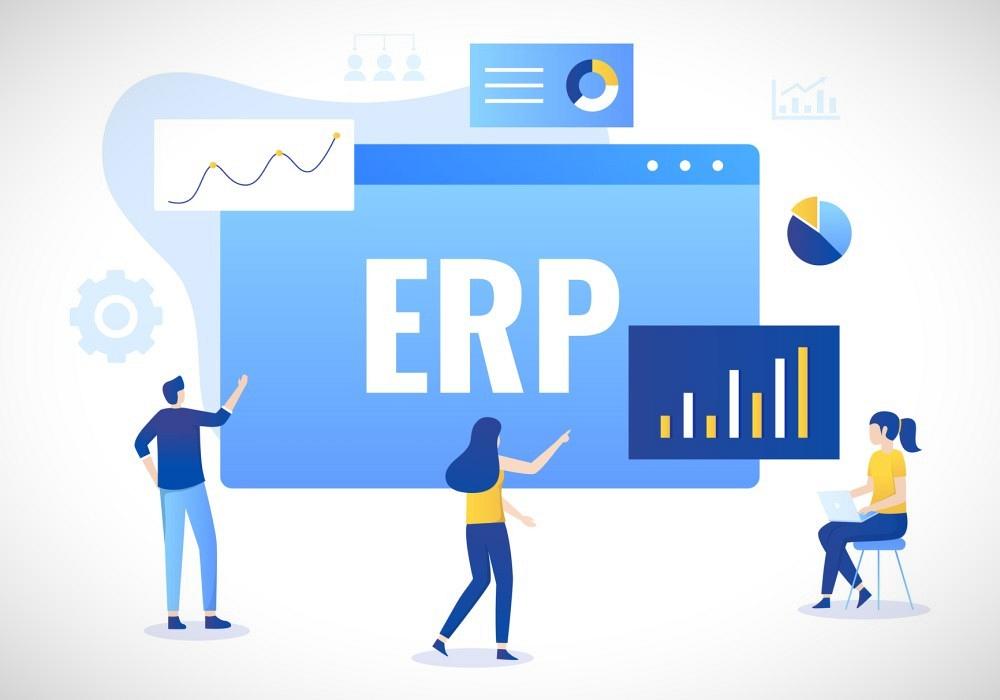Senior Consultant
- FMA
- The Fabricator
- FABTECH
- Canadian Metalworking
Categories
- Additive Manufacturing
- Aluminum Welding
- Arc Welding
- Assembly and Joining
- Automation and Robotics
- Bending and Forming
- Consumables
- Cutting and Weld Prep
- Electric Vehicles
- En Español
- Finishing
- Hydroforming
- Laser Cutting
- Laser Welding
- Machining
- Manufacturing Software
- Materials Handling
- Metals/Materials
- Oxyfuel Cutting
- Plasma Cutting
- Power Tools
- Punching and Other Holemaking
- Roll Forming
- Safety
- Sawing
- Shearing
- Shop Management
- Testing and Measuring
- Tube and Pipe Fabrication
- Tube and Pipe Production
- Waterjet Cutting
Industry Directory
Webcasts
Podcasts
FAB 40
Advertise
Subscribe
Account Login
Search
ERP platform for the metal industry's next generation
How software serves an industry on the cusp of demographical change
- By Dave Lechleitner
- Updated April 18, 2024
- May 5, 2021
- Article
- Manufacturing Software

The industry’s demographics are changing. Shop owners are retiring, and millennials are moving into leadership roles. Can ERP platforms adapt to meet their needs? Getty Images
As the current owners of small and midmarket fabrication shops near retirement age in the next five years, many expect a surge in business succession events. Millennial sons and daughters might have grown up at the shop. They swept the floor and packed parts for shipments. They learned about the technology, the operation, and the customer base. Now it’s their turn. They have the reins.
Part of this leadership transition will involve evaluating core business systems to ensure they will meet the company’s needs over the next 10 to 15 years. This includes perhaps the most important core business system at many metal fabricators: the enterprise resource planning (ERP) platform.
What Is ERP?
An ERP system coordinates activities and processes across an entire fabricating shop to help leaders manage all aspects of its operations: procurement, supply chain, inventory, finance, human resources, payroll, production, project management, equipment maintenance, shop floor operations, sales, and transportation. It helps fab shops manage resource use while maintaining quality, performance, and customer satisfaction, which ultimately can lead to business growth and increased profitability.
Offering real-time data and insights, ERP can help fabricators ensure compliance with regulations and standards, compare metrics across the company, and centralize operational and financial information. Overall, managers can see how the company is performing and use the data to streamline the business and make it more responsive and efficient.
The Millennial Business Leader
Millennials have grown up in using personal computers, mobile phones, tablets, smartwatches, and other devices that keep them connected 24/7. They grew up in a wireless age, with most devices having no need for direct lines or physical cables. They connected with others using no- or low-cost social apps, which could be downloaded on demand and required little or no training to use.
Millennials expect the same experience, level of connectedness, and ease of use in the systems they use in the family business—including their ERP system. Most ERP platforms fabrication shops use today probably were initially developed in the early 1980s or 1990s and had their roots in the even older material requirements and resource planning platforms of the 1970s. Despite regular upgrades, many undoubtedly are showing their age.
Next-generation business owners expect visibility. They want the status of the business operation in real time whenever and wherever they may be. They might need to approve pricing on an estimate, see current shop capacity to commit to a customer delivery requirement, or zero in on a quality issue. The next-generation owner understands how quick response sets a shop apart from the competition.
Subscription Models
Providing data access without limits of time or distance or the need to be tethered to a hard-wired device will be essential to most next-generation owners. To provide such access, however, many traditional and legacy ERP platforms often require complex networking infrastructure or remote desktop capability, with additional layers of security and protocols. All this translates into additional IT requirements, IT staffing, and potential maintenance.
Here, the cloud has played a critical role. Legacy ERP players now host their systems on cloud platforms such as Amazon Web Services, Microsoft Azure, or proprietary cloud infrastructures. With cloud-based ERP has come subscription-based pricing models, with monthly or annual pricing plans that include ongoing infrastructure maintenance, product support, and product upgrades.
Cloud From the Ground Up
Next-generation owners see connectedness as key to future business success. For this reason, many are considering replacing their legacy ERP with a so-called “true cloud” option. Within the past five years, several new software players have developed ERP platform with a cloud-only focus. The new systems have been built from the ground up to optimize the cloud. These new entrants also have prompted a significant shift in the industry, with legacy players re-evaluating and investing heavily in their cloud strategies. They’re either adapting legacy systems to run in the cloud or completely redesigning their platform into new, cloud-based product offerings.
Access on Any Device
New-generation owners want access—either to an entire ERP platform or to key information—on any device, be it a laptop, a smartphone, or tablet. Presenting information can be a challenge, though, especially for legacy platforms that are hosted in the cloud. The ability to see the entirety of available data on a hand-held device is limited. Only certain views or dashboards may be optimized for use on small screens.
Therefore, many ERP vendors have developed mobile applications that offer portions of the entire ERP functionality, such as customer relationship management, key dashboards, and shop floor visibility. Other vendors have invested heavily in giving their platforms a responsive design in which data resizes or reorients itself automatically based on the screen size.
Graphical Business Intelligence
Instead of printed reports, next-generation owners expect highly graphical dashboards or charts that not only summarize the data, but also allow them to drill down in specific areas where they need to know more. Typical dashboards are configured based on the specific user role, and the insight and trending analysis they present aim to help users make responsive business decisions. Dashboard widgets allow a next-generation owner to see a specific condition or trend emerging and, based on that intelligence, take immediate action.
The ERP industry calls these business intelligence (BI) tools, and the latest among them do more than present historical information that has little to no value. Using machine learning and artificial intelligence, BI tools combine past data with likely future trends and, through the use of sophisticated algorithms, show what’s likely to occur. These new predictive analytics tools allow next-generation owners to look farther down the road; they’re not making decisions by looking only in the rear-view mirror.
Integration With Other Systems
Modern fabricators use multiple software tools beyond ERP, everything from product life cycle management (PLM) and nesting systems to other machine automation and production control platforms. Next-generation owners will likely demand seamless integration of all these seemingly disparate tools. They want to work with multiple applications and have everything work together seamlessly—much like how the apps on their smartphones work. Doing so helps maximize efficiency and minimize duplicate data entry, the risk of errors, and costs. They want a configured platform, suited to them and their business, that just works.
But integration hasn’t always been easy. Legacy platforms, ERP or otherwise, might be built on proprietary development platforms or a closed architecture, or have other characteristics that make them difficult to integrate with other software.
Fortunately, modern ERP developers are beginning to understand this issue and are building modern platforms that make the integration challenge almost a thing of the past. Open architecture and standard protocols make integrating ERP to PLM, design software, machine controls, and other systems nearly foolproof. The risk of those integrations failing when one or more platforms move to the next upgrade is minimized or eliminated as well.
A Tailored Solution
Historically, many ERP vendors took a one-size-fits-all approach. What little customization they provided was somewhat limited. Users could rearrange or resort columns or perhaps develop custom reports using a third-party reporting tool. If vendors did customize the underlying programming code, manufacturers usually paid a high price for it, which meant they opted to customize only when it was critical and absolutely necessary to do so.
Customization typically involved programming specialists from the ERP vendor plus the additional time, money, and other resources to validate and test the initial customization against the standard software code. Manufacturers paid a secondary price too: If they wanted to upgrade, they incurred those customization costs. As a result, many operations simply lived with systems that required extra steps or fell short of needed requirements.
Fortunately, modern ERP platforms support easy customization that can be developed, tested, and deployed with little or no intervention from the original software developer. Making this possible are codeless or low-code development platforms similar to Microsoft Visio and other tools. Rather than involving a complex web of programming languages, software packaging, and deployment procedures, these codeless development platforms require just a basic understanding of business process mapping. Before being fully deployed, customizations also can be tested and validated in an isolated “sandbox” environment, where they won’t affect day-to-day operations.
An ERP Metamorphosis
New and legacy ERP developers know that the shop ownership shift is occurring, especially in metal fabrication. As a result, ERP platforms designed for metal fabrication are undergoing a metamorphosis to adapt to the changes the industry’s next-generation owners demand. And legacy players are spending millions (and billions) of dollars to meet these new demands. At the same time, new ERP players are offering platforms built from the ground up with the next generation in mind.
Software has been at the forefront of change and, in some cases, the cause of many of those changes. In just 40 years, software deployment has moved from server rooms and greenscreen “dumb” terminals to having the same capability available on hand-held devices, where users can access terabytes of data for just pennies.
The technologically savvy are moving into leadership roles everywhere, and manufacturing is no exception. The face of the family-run sheet metal fabrication job shop is changing. Metal fabrication’s next-generation leaders will have a lasting impact on manufacturing ERP, and its evolution will only accelerate in the coming years.
About the Author
Dave Lechleitner
939 W. North Ave., Suite 750
Chicago, IL 60642
312-319-1411
subscribe now

The Fabricator is North America's leading magazine for the metal forming and fabricating industry. The magazine delivers the news, technical articles, and case histories that enable fabricators to do their jobs more efficiently. The Fabricator has served the industry since 1970.
start your free subscription- Stay connected from anywhere

Easily access valuable industry resources now with full access to the digital edition of The Fabricator.

Easily access valuable industry resources now with full access to the digital edition of The Welder.

Easily access valuable industry resources now with full access to the digital edition of The Tube and Pipe Journal.
- Podcasting
- Podcast:
- The Fabricator Podcast
- Published:
- 04/16/2024
- Running Time:
- 63:29
In this episode of The Fabricator Podcast, Caleb Chamberlain, co-founder and CEO of OSH Cut, discusses his company’s...
- Trending Articles
AI, machine learning, and the future of metal fabrication

Employee ownership: The best way to ensure engagement

Steel industry reacts to Nucor’s new weekly published HRC price

Dynamic Metal blossoms with each passing year

Metal fabrication management: A guide for new supervisors

- Industry Events
16th Annual Safety Conference
- April 30 - May 1, 2024
- Elgin,
Pipe and Tube Conference
- May 21 - 22, 2024
- Omaha, NE
World-Class Roll Forming Workshop
- June 5 - 6, 2024
- Louisville, KY
Advanced Laser Application Workshop
- June 25 - 27, 2024
- Novi, MI



























